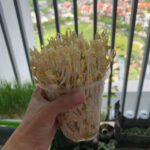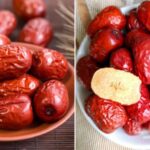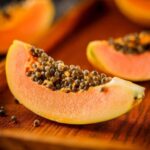Durian, often dubbed the “king of fruits,” boasts distinctive characteristics not only in its appearance but also in its flavor. The creamy flesh of the durian offers an incredibly rich sensory experience with its creamy, sweet, and soft texture, making it hard to forget for anyone who has tasted it.
The allure of this fruit goes beyond its unique taste, as it is also a nutrient-rich source. Durian is packed with vitamin C, potassium, and fiber, all of which are essential for the body. These nutrients not only improve overall health but also boost immunity, offering multiple health benefits to consumers.

Durian, the “king of fruits,” stands out in both appearance and flavor.
How to Distinguish Between Male and Female Durian Trees
The differentiation between female and male durian trees is often based on folk beliefs rather than scientific grounds, as durian fruits do not have a gender distinction. Among growers, female trees are generally favored. Gardeners believe that female trees bear fruit with better flavor, larger segments, golden flesh, and more appealing taste than male trees. This naming convention stems from a preference for the fruit’s flavor and quality rather than biological characteristics.
To choose a delicious and high-quality female durian, there are some simple secrets that gardeners often share. Specifically, pay attention to the shape of the base of the durian. The base of a female durian is usually wider and flatter, resembling a flat star, while a male durian has a sharper base, resembling a mace at first glance.

Female durians are usually rounder with fuller, creamier flesh, while male durians are taller and thinner.
How to Choose a Delicious Durian
To select the best-tasting durians, in addition to identifying a female durian, you can apply some other helpful methods below:
Inspect the Fruit’s Skin
A critical indicator of a delicious durian is the thinness of its skin. Durians with thinner skins tend to have more flesh and a sweeter taste. To assess the skin thickness, gently tap the fruit; if it sounds hollow, it’s likely a thin-skinned durian.
Observe the Skin’s Texture
Pay attention to the texture of the durian’s skin. Fruits with thinner skins usually have more defined textures and better elasticity. Avoid durians with hard and thick skins like rocks, as they often have tough flesh that lacks the creaminess of those with thinner skins.

Thinner-skinned durians usually have more defined textures and better elasticity.
Assess the Flesh’s Firmness and Color
When choosing a cut durian, it’s crucial to observe the firmness and hue of the flesh to gauge its quality. A delicious durian will have thick, firm flesh and a bright yellow color. If the flesh appears loose or dark, it may indicate over-ripeness or poor storage conditions. Delicious durians typically have resilient flesh with vibrant colors, signifying a sweet taste.
If you’re buying a whole durian, gently press the fruit to test its firmness and elasticity. This helps you select higher-quality durians.
Pay Attention to the Aroma
The fragrance is an essential aspect that reflects the quality of the durian. Ripe durians usually emit a strong, sweet aroma. The degree of ripeness and sweetness of the durian is often conveyed through its distinctive scent. A ripe durian will have a sweet fragrance that isn’t overly pungent. If you detect an overly sharp or fermented odor, it may indicate over-ripeness.
On the other hand, if the aroma is faint, the durian may not have reached the desired level of ripeness.
The Secret to Vibrant Roses: Unveiling the 2 Essential ‘Miracle Workers’ You Need to Know About
Are you eager to transform your rose garden into a vibrant and blooming oasis? Discover the two “secret ingredients” that roses absolutely adore. One is tailored to promote vigorous growth, while the other works its magic to encourage larger, more beautiful blooms that last longer. Uncover the key to a stunning rose garden that will be the envy of your neighborhood.
12 Ingenious Ways to Grow Bean Sprouts at Home Using Everyday Items
“Discover the secrets to growing delicious and plump bean sprouts at home with ease and speed. Uncover the simple methods using everyday kitchen items such as plastic baskets, bottles, milk cartons, and towels. Learn how to master the art of sprouting and enjoy the freshest ingredient in your meals.”






































